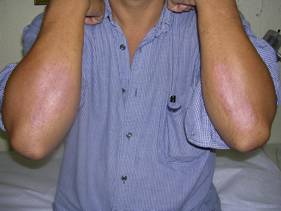Back To Pamphlet Listing
Psoriasis
What is psoriasis?
This is an inflammatory skin disease in which there is increased skin turnover causing a well defined red, scaly rash most commonly on scalp, elbows, knees and lower back. The nails and joints may also be affected by the disorder.
Who gets psoriasis?
Although all races can be affected, it is most common in Indians.
What causes psoriasis?
This is not clear. About a third of cases run in families. There is believed to be a dysfunction of the immune system, however it is not catching.
The disease can be triggered by the following:
- Some bacterial infections (Strep.)
- Alcohol
- Some medications e.g. lithium, beta blockers (blood pressure medication), steroids in some situations.
What types of psoriasis are there?
- Common plaque psorisis – red, scaly raised lesions on both sides of the body in the sites mentioned above.

- Guttate psoriasis – Many smaller raindrop-like lesions in adolescents/young adults usually trigerred by a Strep. Infection
- Flexural psoriasis – Rash involves creases of the body
- Erthrodermic psoriasis – Greater than 90% of the body is red and scaly and the patient is usually quite ill.
- Pustular psoriasis – Pus bumps, reddness and scaling localized to the palms and soles or generalized, in which case the patient is usually ill.
- Joint involvement with pain and swelling especially affecting the fingers and lower back
- Nail – May get pitting, oil drop discolouration, lifting of nail, debris under nail
How can psoriasis be treated?
There are a number of treatment options depending on the type and severity of psoariais. These include:
Topical
- Coal tar
- Dithranol
- Vitamin D derivatives
- Salicylic acid mixtures
- Steroids
- Moisturizers
UV light therapy
Oral/Injectables
- Immune suppressing medications
Hospitalization may be required for severe and extensive cases.
|

